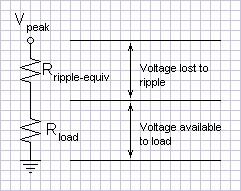 |
| Home │ Audio
Home Page |
Copyright © 2009 by Wayne Stegall
Updated October 13, 2010. See Document History at end for details.
Basic Electronics
Power Supply
Ripple Calculations and Capacitor Size
| Figure
1:
Graph
of
full-wave
rectification
with
capacitor ripple |
 |
The peak voltage from a transformer (1.414 x Vrms) has to be derated by the ripple voltage and diode drop before furthur power supply calculations can be done. Ripple calculations are derived from the capacitor formula. Because this formula is common and important, it may be better to remember the capacitor formula
Begin with the capacitor formula (current = capacitance x rate of change of voltage)
| (1) |
i = C | δv δt |
Change instantaneous slope (δv/δt) to constant slope over finite interval (Δv/Δt) and solve it for voltage change.
| (2) |
Δv = | iΔt
C |
It may be more convenient to relate Δt as frequency instead. Substitute 1/f for Δt in equation (2).
| (3) |
Δv = | i
fC |
Example:
Given full wave rectification, a load current of 3.5A, and a capacitance of 6800µF, calculate the ripple voltage.
| From equation (3) |
Δv = | 3.5A
120Hz x 6800µF |
=
4.29V |
As for the thought that lead to this article. Reading that 47 Labs used 1000µF in its Gaincard amplifier power supplies puzzled me. Do more powerful amplifiers require larger capacitors? On first impression it seems so. However, lets rearrange our ripple equation again.
| (4) |
Δv
i |
= |
1
fC |
| Figure 2: Schematic of
ripple abstraction |
 |
The equivalent output impedance with the above mentioned 1000µF filter capacitors is:
| From equation (4) |
Δv
i |
= |
1
120Hz x 1000µF |
= 8.33Ω |
What of the answer to the question posed?1 Capacitor size does not need to increase with the size of the amplifier unless insufficient amplifier feedback factor (or insufficient regulation in the case of regulated power supplies) makes power supply hum a real issue.
|
|
Document History
December 6, 2009 created.
October 13, 2010 Corrected grammer of one sentence.